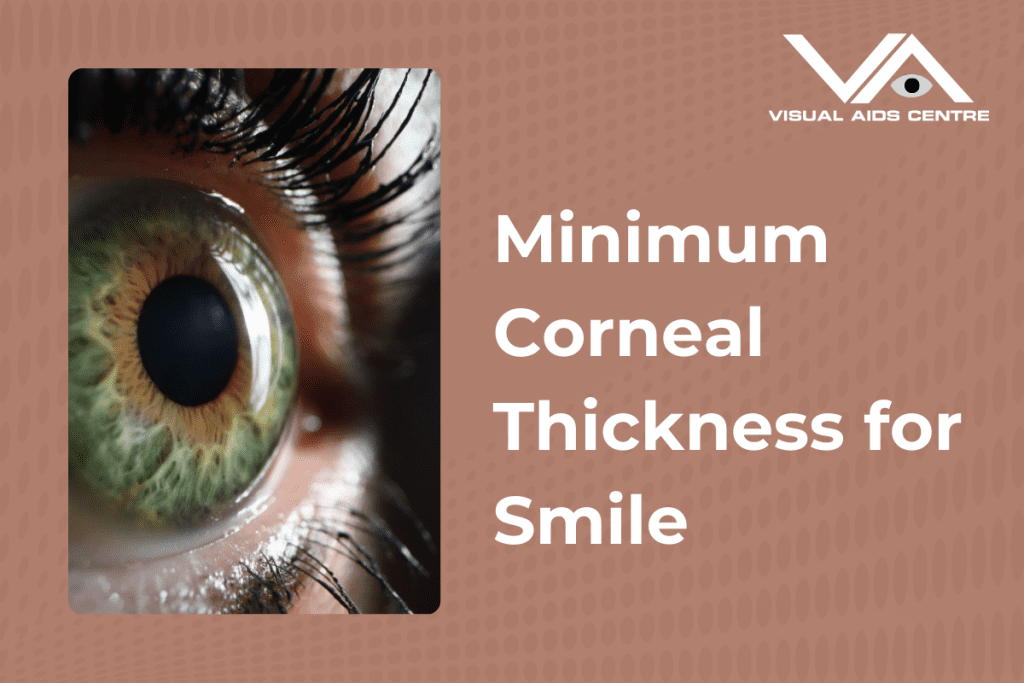Table of Contents
ToggleIn the ever-changing world of laser eye surgery, SMILE (Small Incision Lenticule Extraction) emerges as a groundbreaking procedure. It offers a minimally invasive and flapless solution for correcting myopia and astigmatism.
As you consider the prospect of freeing yourself from the confines of glasses or contact lenses, it is crucial to grasp the pivotal role that corneal thickness plays in determining your eligibility for this revolutionary surgery.

SMILE in a Nutshell
Before delving into the specifics of corneal thickness, let’s grasp the essence of SMILE.
Envision the creation of a thin lenticule inside your cornea, precisely reshaping the cornea with laser technology to correct your nearsightedness (myopia) with or without astigmatism. This is essentially the remarkable capability of SMILE.
Unlike LASIK, which involves creating a corneal flap, the SMILE procedure leaves the surface untouched and instead makes a small incision.
With FDA (US Food and Drug Administration) approval and a remarkable track record of treating over 8 million eyes worldwide, this flapless approach offers several advantages:
- Quicker recovery:
SMILE typically leads to faster healing compared to LASIK, with many patients experiencing improved vision within hours. - Reduced risk of dry eye:
By preserving the corneal nerves, SMILE minimizes the likelihood of post-operative dry eye, a common issue after LASIK. - Swift procedure:
The SMILE procedure is efficient, with the laser portion taking an average of approximately 22 seconds per eye and the entire procedure usually lasting between 10 to 20 minutes per eye.
SMILE’s Advantage: Structural Integrity
SMILE offers a unique advantage over other laser eye surgeries by preserving the structural integrity of the cornea. With a small incision and extraction of deeper layers of corneal tissue, it provides exceptional results while maintaining the utmost precision.
Research findings suggest that the anterior 40% of the cornea is approximately twice as resilient as the posterior 60%.
Leveraging this strength, SMILE surgery distinguishes itself from procedures such as LASIK or ASA by preserving the anterior layers. This preservation not only enhances the cornea’s biomechanical integrity but also mitigates the risk of long-term corneal shape changes, a crucial factor for the surgery’s overall success.
Here’s Where the Numbers Come In
The cornea, which is the transparent outer layer of the eye, serves as a protective dome. Its thickness is vital for maintaining the shape of the eye and ensuring good vision health.
During laser surgeries, the corneal thickness is inherently reduced.
The minimum corneal thickness depends on the individual’s prescription. The higher the prescription and the larger the treated area (optical zone) needed, the more tissue needs to be removed (extracted as a lenticule in the case of SMILE).
To undergo SMILE, it is recommended that the central corneal thickness is a minimum of 500 microns (µm), preferably even thicker.
Why?
Because the procedure involves the removal of corneal tissue, surpassing the minimum threshold guarantees an ample amount of residual cornea for optimal stability.
As part of the consultation process, your surgeon will assess the thickness of your cornea to determine if you meet the required criterion.
Understanding the Numbers Game
- 500 microns:
This is considered the ideal corneal thickness for SMILE candidacy. Numerous studies have demonstrated outstanding outcomes with corneas at this thickness, with minimal risk of complications such as corneal ectasia (a bulging of the cornea). - 490-499 microns:
In this range, some surgeons may cautiously evaluate the suitability of SMILE based on additional factors such as your specific prescription and the thickness of the remaining cornea after tissue removal (known as residual stromal bed thickness). However, it is crucial to approach such cases with utmost caution and conduct thorough pre-operative assessments. - Below 490 microns:
Corneas that are thinner than this threshold are generally not recommended for SMILE due to the heightened risk of compromising the corneal structure and weakening its integrity.
More Than Just a Number
While corneal thickness is an important factor, it’s not the sole determinant of your eligibility for SMILE. Your doctor will also take into account the following considerations:
- Age and stability:
SMILE is typically recommended for individuals aged 18 and above, and your prescription should have remained stable for at least one year. - Overall eye health:
Pre-existing eye conditions such as glaucoma, cataracts, or retinal diseases can disqualify you from undergoing SMILE. - Medical history:
Certain medical conditions like diabetes, autoimmune diseases, hepatitis C, herpes, rheumatoid arthritis, lupus, or the need for immunosuppressant drugs may also pose risks or disqualify you from SMILE. - Pregnancy or breastfeeding:
Individuals who are pregnant or breastfeeding are not eligible for SMILE.
The SMILE procedure is suitable for individuals with the following eyesight parameters:
- Sphere:
-0.5 to -10.00 Diopters - Astigmatism:
0.0 to 5.00 Diopters - Spherical equivalent:
up to -12.50 Diopters
Exploring Alternatives for Thin Corneas
If your corneal thickness is below the ideal range for SMILE, don’t worry! There are several alternative laser vision correction options available for thinner corneas, including:
- TransPRK (Transepithelial PhotoRefractive Keratectomy):
This flapless technique directly reshapes the corneal surface without creating a flap. While the recovery time might be slower compared to SMILE, it is a suitable option for thinner corneas. - ICL (Implantable Collamer Lens):
This implantable lens is placed within the eye to correct refractive errors without touching the cornea. It offers a viable solution for individuals with thin corneas. - A Personalized Approach:
SMILE presents a groundbreaking approach to laser vision correction, offering the enticing prospect of freedom from glasses or contacts. However, embarking on this journey requires a comprehensive understanding of the minimum corneal thickness necessary for a successful and enduring SMILE experience.
Remember, it’s not merely about a numerical value; it’s about safeguarding the long-term health and stability of your precious eyes. Prioritize a detailed consultation with your ophthalmologist, where you can openly discuss your concerns. Together, you can navigate the realm of laser vision correction and discover the path to clear, confident vision.









